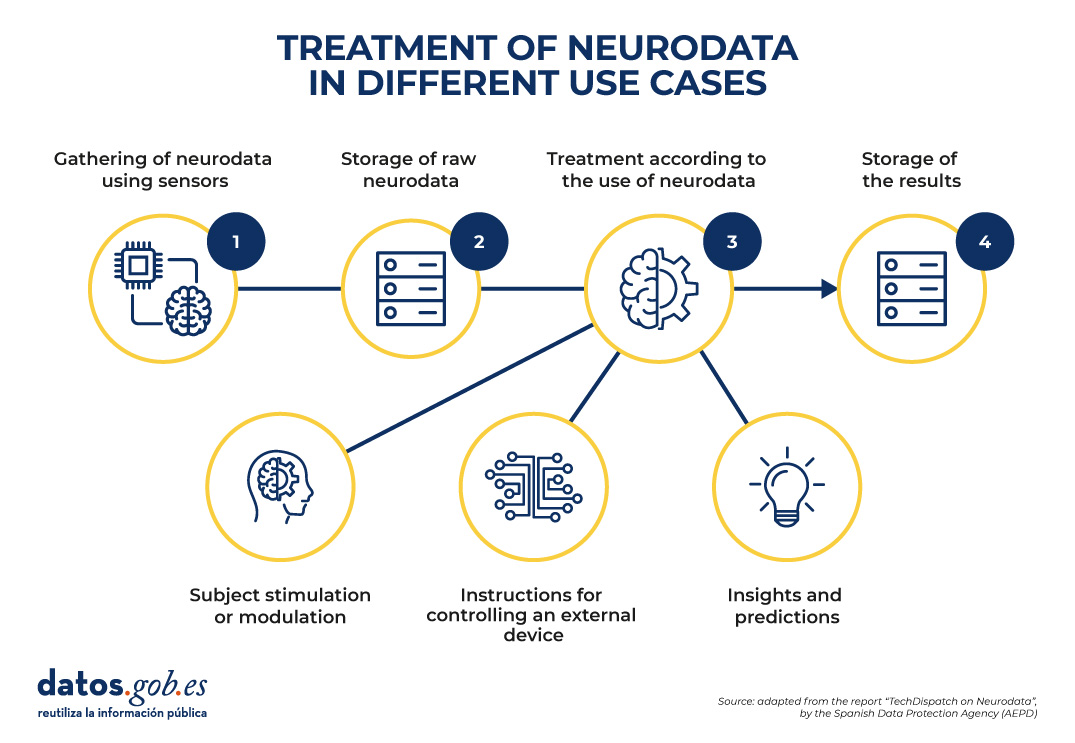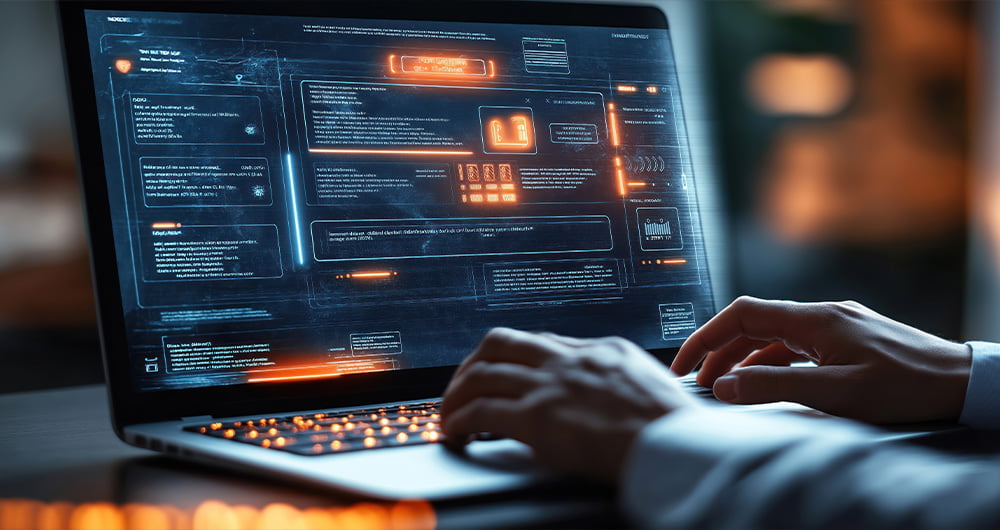
Imagine a machine that can tell if you're happy, worried, or about to make a decision, even before you know clearly. Although it sounds like science fiction, that future is already starting to take shape. Thanks to advances in neuroscience and technology, today we can record, analyze, and even predict certain patterns of brain activity. The data that is generated from these records is known as neurodata.
In this article we will explain this concept, as well as potential use cases, based on the report "TechDispatch on Neurodata", of the Spanish Data Protection Agency (AEPD).
What is neurodata and how is it collected?
The term neurodata refers to data that is collected directly from the brain and nervous system, using technologies such as electroencephalography (EEG), functional magnetic resonance imaging (fMRI), neural implants, or even brain-computer interfaces. In this sense, its uptake is driven by neurotechnologies.
According to the OECD, neurotechnologies are identified with "devices and procedures that are used to access, investigate, evaluate, manipulate, and emulate the structure and function of neural systems." Neurotechnologies can be invasive (if they require brain-computer interfaces that are surgically implanted in the brain) or non-invasive, with interfaces that are placed outside the body (such as glasses or headbands).
There are also two common ways to collect data:
- Passive collection, where data is captured on a regular basis without the subject having to perform any specific activity.
- Active collection, where data is collected while users perform a specific activity. For example, thinking explicitly about something, answering questions, performing physical tasks, or receiving certain stimuli.
Potential use cases
Once the raw data has been collected, it is stored and processed. The treatment will vary according to the purpose and the intended use of the neurodata.

Figure 1. Common structure to understand the processing of neurodata in different use cases. Source: "TechDispatch Report on Neurodata", by the Spanish Data Protection Agency (AEPD).
As can be seen in the image above, the Spanish Data Protection Agency has identified 3 possible purposes:
-
Neurodata processing to acquire direct knowledge and/or make predictions.
Neurodata can uncover patterns that decode brain activity in a variety of industries, including:
-
Health: Neurodata facilitates research into the functioning of the brain and nervous system, making it possible to detect signs of neurological or mental diseases, make early diagnoses, and predict their behavior. This facilitates personalized treatment from very early stages. Its impact can be remarkable, for example, in the fight against Alzheimer's, epilepsy or depression.
-
Education: through brain stimuli, students' performance and learning outcomes can be analyzed. For example, students' attention or cognitive effort can be measured. By cross-referencing this data with other internal (such as student preferences) and external (such as classroom conditions or teaching methodology) aspects, decisions can be made aimed at adapting the pace of teaching.
-
Marketing, economics and leisure: the brain's response to certain stimuli can be analysed to improve leisure products or advertising campaigns. The objective is to know the motivations and preferences that impact decision-making. They can also be used in the workplace, to track employees, learn about their skills, or determine how they perform under pressure.
- Safety and surveillance: Neurodata can be used to monitor factors that affect drivers or pilots, such as drowsiness or inattention, and thus prevent accidents.
-
Neurodata processing to control applications or devices.
As in the previous stage, it involves the collection and analysis of information for decision-making, but it also involves an additional operation: the generation of actions through mental impulses. Let's look at several examples:
-
Orthopaedic or prosthetic aids, medical implants or environment-assisted living: thanks to technologies such as brain-computer interfaces, it is possible to design prostheses that respond to the user's intention through brain activity. In addition, neurodata can be integrated with smart home systems to anticipate needs, adjust the environment to the user's emotional or cognitive states, and even issue alerts for early signs of neurological deterioration. This can lead to an improvement in patients' autonomy and quality of life.
- Robotics: The user's neural signals can be interpreted to control machinery, precision devices or applications without the need to use hands. This allows, for example, a person to operate a robotic arm or a surgical tool simply with their thinking, which is especially valuable in environments where extreme precision is required or when the operator has reduced mobility.
- Video games, virtual reality and metaverse: since neurodata allows software devices to be controlled, brain-computer interfaces can be developed that make it possible to manage characters or perform actions within a game, only with the mind, without the need for physical controls. This not only increases player immersion, but opens the door to more inclusive and personalized experiences.
- Defense: Soldiers can operate weapons systems, unmanned vehicles, drones, or explosive ordnance disposal robots remotely, increasing personal safety and operational efficiency in critical situations.
-
Neurodata treatment for the stimulation or modulation of the subject, achieving neurofeedback.
In this case, signals from the brain (outputs) are used to generate new signals that feed back into the brain (such as inputs), which involves the control of brain waves. It is the most complex field from an ethical point of view, since actions could be generated that the user is not aware of. Some examples are:
-
Psychology: Neurodata has the potential to change the way the brain responds to certain stimuli. They can therefore be used as a therapy method to treat ADHD (Attention Deficit Hyperactivity Disorder), anxiety, depression, epilepsy, autism spectrum disorder, insomnia or drug addiction, among others.
- Neuroenhancement: They can also be used to improve cognitive and affective abilities in healthy people. Through the analysis and personalized stimulation of brain activity, it is possible to optimize functions such as memory, concentration, decision-making or emotional management.
Ethical challenges of the use of neurodata
As we have seen, although the potential of neurodata is enormous, it also poses great ethical and legal challenges. Unlike other types of data, neurodata can reveal deeply intimate aspects of a person, such as their desires, emotions, fears, or intentions. This opens the door to potential misuses, such as manipulation, covert surveillance, or discrimination based on neural features. In addition, they can be collected remotely and acted upon without the subject being aware of the manipulation.
This has generated a debate about the need for new rights, such as neurorights, which seek to protect mental privacy, personal identity and cognitive freedom. Various international organizations, including the European Union, are taking measures to address these challenges and advance in the creation of regulatory and ethical frameworks that protect fundamental rights in the use of neurotechnological technologies. We will soon publish an article that will delve into these aspects.
In conclusion, neurodata is a very promising advance, but not without challenges. Its ability to transform sectors such as health, education or robotics is undeniable, but so are the ethical and legal challenges posed by its use. As we move towards a future where mind and machine are increasingly connected, it is crucial to establish regulatory frameworks that ensure the protection of human rights, especially mental privacy and individual autonomy. In this way, we will be able to harness the full potential of neurodata in a fair, safe and responsible way, for the benefit of society as a whole.


